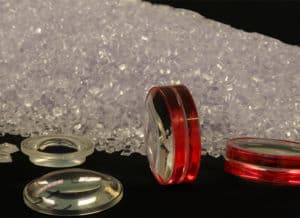
Injection Moulding of Plastic Optics
Precision injection molding is a proven and highly efficient method for manufacturing complex plastic optics at scale. It allows for high repeatability, excellent surface quality, and design freedom – all essential factors in modern optical applications.
While this process offers many advantages over traditional glass optics manufacturing, it also presents unique challenges, particularly in terms of material handling and process control.
Key Advantages of Injection Molding for Optical Components
1. Cost-Efficient Mass Production
Injection molding enables the economical production of high volumes with consistent optical quality. Compared to traditional grinding and polishing of glass, cycle times are significantly reduced.
2. Design Freedom for Complex Geometries
The process supports the replication of aspheric lenses, freeform surfaces, and diffractive structures – allowing for highly integrated and compact optical designs.
3. Lightweight and Durable
Plastic optics are significantly lighter than glass and offer better impact resistance. This makes them ideal for mobile, automotive, and wearable applications.
4. Functional Integration
Advanced polymers allow for added functionalities like UV filtering, infrared transmission, or anti-reflective coatings – all achievable within a single component design.
Challenges in Precision Molding of Optical Plastics
1. Material Selection
Choosing the right material is critical. Common options include PMMA (Acrylic), Polycarbonate, and COC/COP, depending on the optical requirements, thermal stability, and mechanical properties.
2. Tooling and Mold Precision
High-precision molds are essential. Even the smallest deviations in form, shrinkage, or surface finish can cause optical aberrations or reduce transmission efficiency.
3. Cleanroom Production Environment
Since dust, particles, or surface defects severely affect optical performance, production typically takes place in controlled cleanroom conditions with strict process monitoring.
4. Surface Coatings and Finishing
Despite excellent surface replication, some applications require additional coatings such as hard coatings or anti-reflective layers for durability and performance enhancement.
Conclusion
Injection molding of plastic optics offers a powerful path toward cost-efficient, lightweight, and flexible optical component manufacturing. With the right combination of material selection, tooling precision, and process expertise, high-performance lenses and optical systems can be manufactured at scale.
Interested in more insights into advanced optical manufacturing?
📌 Follow our blog for updates on prototyping, material selection, and custom optical design.
